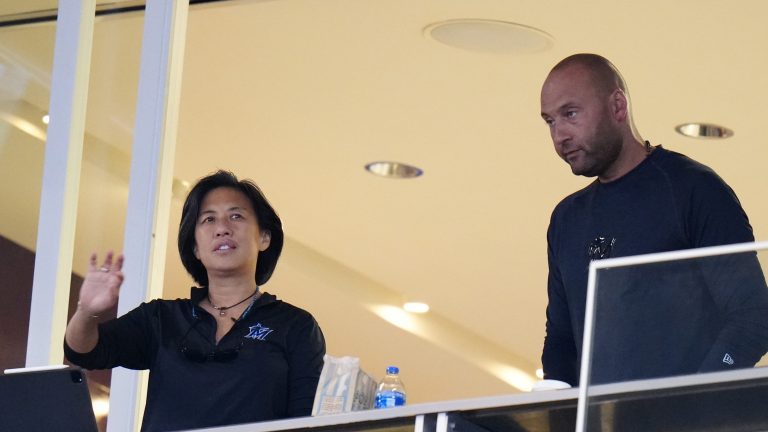Derek Jeter’s Departure Has Fans Wondering What’s Next
Derek Jeter stepping down as the Marlins CEO opens the door for GM Kim Ng to take a more prominent leadership role moving forward.

Today was set to be a big day for headlines in Major League Baseball as the league is expected to hit its self-imposed deadline to reach an agreement in CBA talks. Instead, Derek Jeter and the Miami Marlins caught the baseball world by storm by announcing that the two sides had agreed to mutually part ways.
Despite news of this magnitude usually causing passionate responses, the most common reaction from Marlins fans has been not knowing how to react.
Major League Baseball has a weird thing with titles. Jeter, along with Bruce Sherman and other investors, purchased the Marlins in 2017 and the Hall of Fame shortstop was appointed the “CEO” of the team. Oftentimes, it’s the “President” or “Director of Player Operations” that will be the one making the decisions when it comes to player personnel. Other organizations still allow for the General Manager to call the shots in the way the role was always understood. It really is all semantics. In the Marlins’ case, Jeter was the guy calling the shots.
When Jeter was given the reins to the franchise by the purchasing group, he had 2,747 MLB games under his belt. The misconception made by Bruce Sherman and his group was that playing nearly 3,000 MLB games could make up for zero days of executive experience in a professional baseball team’s front office.
Optically, it made sense. South Florida was in desperate need of buzz around baseball, and what better way to do it than by landing one of the game’s most beloved figures?
The problem is, optics don’t win baseball games. And soon enough, fans could see through it.
This is not all on Jeter, after all. He didn’t force anyone to make him the CEO and his $25 million contribution to the purchase of the team, in the grand scheme of things, is just a drop in the bucket. Jeter had known nothing but success in his career, and the purchasing group expected that success to continue into the second phase of his baseball life.
Still, when you consider Jeter’s inexperience, along with the hefty $5 million annual salary he was commanding, it is fair to wonder if the Marlins are now better off moving in another direction.
Jeter said in his statement that “the vision for the future of the franchise is different than the one I signed up to lead.” This vague statement led many to speculate that the disconnect between Jeter and ownership had to do with a willingness to spend money; a theory that the Miami Herald’s Craig Mish debunked.
After all, the Marlins inked Avisail Garcia to a four-year, $53 million deal prior to the lockout which was the largest contract the franchise has dished out since the previous ownership inexplicably shelled out $80 million over five seasons to Wei-Yin Chen. The Marlins also extended ace Sandy Alcantara to a five-year, $56 million deal this winter. By all accounts, the Marlins plan to invest a bit more into their payroll on the other side of the lockout, being connected to names like Kyle Schwarber, Nick Castellanos, Kenley Jansen and others.
Despite the financial commitment made by the Marlins at the end of 2021, the team as currently constructed is only projected to have a payroll around $55 million, which is good for the fourth-lowest in baseball. If the Marlins commit another $15 million to next year’s payroll, the team will be closer to the middle of the pack in that department. This isn’t necessarily groundbreaking, but expecting the Marlins to be in the top half of the league in payroll was never a realistic part of the plan. And, Derek Jeter knew that.
In fact, on numerous occasions, Jeter said himself that the team would succeed by building from the ground up by investing in player development and then spending in the right spots. The Marlins overhauled their player development department when Jeter brought in Gary Denbo from the Yankees to be the team’s Vice President of Player Development and Scouting. According to Ken Rosenthal, by the time the 2017 General Managers’ Meetings kicked off six weeks after Denbo’s hiring, he was the one leading conversations, not then-President of Baseball Operations Michael Hill.
Again, the semantics of an MLB title comes into play here. Denbo was well-documented as Jeter’s right-hand man and someone who had a say on most moves. As chronicled by Rosenthal, Denbo is a polarizing figure whose approach often rubs colleagues and players the wrong way.
There have been some positives from Denbo and Marlins player development in the pitching department, where the organization has accumulated an enviable amount of pitching depth. But on the position player side of things, the Marlins have not been good. An antiquated approach to scouting and development has not helped the Marlins in their lack of ability to both identify and develop bats. Simply put, the Marlins are behind when it comes to the data and support that they provide their hitters.
“Knowing what some other organizations had at their disposal compared to us was frustrating,” one former Marlins farmhand told Just Baseball. “We felt like we were at a disadvantage.”
It won’t come to the surprise of many that the Marlins Double-A affiliate, the Pensacola Blue Wahoos, posted the worst OPS in Double-A South. The Jacksonville Jumbo Shrimp were among the worst in Triple-A in the OPS department as well.
Every organization is going to have strengths and weaknesses, but being able to leverage the strengths to hedge the weaknesses is key. It seemed as though the Marlins front office was often unwilling to recognize its shortcomings; whether it was the team’s willingness to continue to roll failed prospects Lewis Brinson, Isan Diaz and Magneuris Sierra into the lineup or shifting their approach to scouting and developing offensive pieces.
The Marlins front office had become a bit of an echo chamber rather than challenging the status quo–which wasn’t working–and inspiring different perspectives. As a result, we saw the Marlins make many of the same mistakes when it came to the types of hitters they targeted and the team’s reluctance to move on from them.
Fans typically will judge an executive on the player personnel moves that they make. That is what is actively visible. The reality is, one of the most important aspects of an executive’s gig, in any sport, is to build the best staff possible. This could understandably be a tall task for a baseball executive with no prior experience. Beyond the baseball side of things, the same limitations can be seen in the way the Marlins approached the business operations side as well.
In February of 2018, the Marlins brought in Chip Bowers to be the team’s new President of Business Operations. Bowers left his gig with the Golden State Warriors and set his sights on trying to help turn things around in Miami. Fourteen months later, Bowers was setting his sights on a new job. The Marlins fired Bowers with little public explanation.
“This has to do with our overall business strategy, accountability and we felt as though a change was needed in the leadership group,” Jeter said in May of 2019.
Last November, the Marlins made history when they hired Kim Ng to be the team’s next General Manager. In doing so, Ng became the first female General Manager of a men’s team in the history of major North American professional sports.
Compared to Jeter, Ng had earned her standing atop an MLB front office through decades of experience working as a rising executive in the game. First hired full-time by the Chicago White Sox back in 1991, Ng has worked for various teams including serving as the assistant GM for the New York Yankees and Los Angeles Dodgers.
The hiring of Ng was exciting on many fronts for Marlins fans. Beyond the fact that Ng broke the glass ceiling for women in baseball, her most recent stint with a club was ten years with one of the best run organizations in sports in the Dodgers. The belief ahead of the 2021 season was that Ng would provide a fresh perspective for the Marlins front office.
Similarly to how Michael Hill’s hands were tied, Ng experienced much of the same. Jeter and Denbo weighed in and often made the executive decisions on many moves. Jeter often called the front office environment as “collaborative” but there did not seem to be much change to the team’s approach after Ng’s hiring.
If it were up to Kim Ng, I find it hard to believe she would want to stick with Lewis Brinson, Isan Diaz, Jorge Alfaro and Magneuris Sierra for as long as the Marlins did. Ng’s hands were tied, yet she was the one taking the hits in press conferences and wearing the mistakes. There was nothing collaborative about that.
We may never know the exact reasons for Derek Jeter’s departure, but I find it hard to believe that it was all centered around the idea that Jeter is a winner and he did not see winning in the Marlins future. The Marlins front office put a lot of faith in Jeter. When a small market team invests the same amount into their CEO as their starting shortstop (Miguel Rojas), ownership is probably going to let him do his thing.
Now, it looks like the experienced Kim Ng will be able to do her thing. It remains to be seen if Denbo will be the next shoe to drop, but given that he was Jeter’s guy, I’d deem his departure likely. From what I have gathered, this would not be a bad thing in the eyes of many of the Marlins minor leaguers.
This does not necessarily mean a step back for the Marlins. Forget who Derek Jeter the baseball player was for a second and let’s focus on Jeter the executive. Assuming that Jeter’s departure means increased responsibility and free rein for Kim Ng, the Marlins are effectively replacing a decision maker with no prior front office experience with one of the most experienced second year GM’s MLB has seen.
The Marlins are not all that far off from putting things together and a fresh perspective may just be what this organization needs to take them across the finish line.

